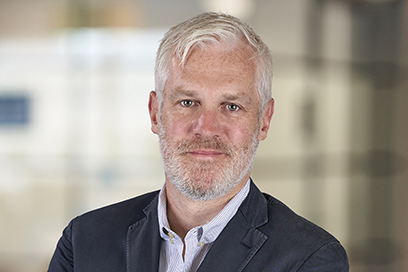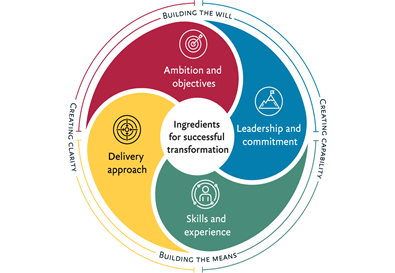In part one of this two-part series, discover how to deliver real net zero progress by developing the right leadership capability and understanding the specific drivers of change for your organisation and sector.
The imperative for businesses to act on climate change and net zero is clear and well established. Not only is it the right thing to do for the environment, but it’s essential for future business success.
In many organisations, the responsibility for climate action and net zero used to sit with a specialist sustainability function to the side of the core business. In some organisations it still does.
Given the nature, magnitude and immediacy of the challenge, this is no longer sufficient (if it ever was). The transition to net zero needs to be at the very heart of your business strategy, not only in terms of how your business runs, but also how and where it competes and wins.
The Berkeley Partnership has partnered with not-for-profit organisation Chapter Zero to develop the Board Toolkit which proposes five key steps to help businesses rise to these challenges.

1. Lead from a position of knowledge on net zero transition
Recent research found that 75% of board members believe that climate change is very or entirely important to the strategic success of their companies. In stark contrast, 85% said their board needs to increase its climate knowledge.
Board members don’t have to be climate experts, but they do need enough of an understanding to provide effective, well-informed leadership. An appropriate level of knowledge about climate change and the net zero transition should be a fundamental part of board and senior executive competency frameworks, and appropriately built into recruitment and development processes.
Boards and executive leadership teams also need ready access to specialist expertise to help inform strategic direction and monitor performance, so ensure you are appointing the right people and suppliers, with a proven track record, to provide that support. Key areas of expertise will include emissions measurement and target setting; opportunities for low carbon technologies and innovations in your sector; and climate change and net zero risk assessment.
2. Understand the drivers of change for net zero transition
As with all strategy development, it is vital to understand the key drivers of change for your sector and business. When defining your strategy for climate change and the net zero transition, the following key factors should be considered under a range of temperature scenarios over the short, medium and longer (i.e. 10+ year) timeframe.
Determine in specific, measurable terms what greenhouse gas (GHG) emissions your business creates, measured in CO2 equivalents.
To get a complete picture, it is vital to look at:
- GHG emissions you produce directly (Scope 1)
- Emissions generated indirectly
- Via purchased electricity, steam, heating and cooling you consume (Scope 2)
- Throughout your end-to-end value chain, both in your upstream supply chain and downstream in the way your products are marketed, distributed and used (Scope 3).
In some sectors, indirect emissions form the vast majority of total emissions, so a whole value chain assessment is essential. For example, Kraft Heinz recently established that 95% of the emissions created by their business were Scope 3.
To establish potential climate-related opportunities to improve business performance, look at emerging trends, such as low-carbon technology innovation, renewable energy, government funding and incentives, carbon pricing, and stakeholder sentiment.
Consider both efficiency opportunities (e.g. reducing energy consumption) and growth opportunities (e.g. new or different positioning, products, services, propositions and markets).
Conduct analysis to identify, measure and mitigate risk across your end-to-end value chain. These will include:
- Physical risks: Risk of losses resulting from climate change, which may be chronic (resulting from sustained, long term effects, such as rising sea levels) or acute (resulting from individual climate-driven events, such as severe storms)
- Transition risks: Risks resulting from societal, legislative, technological and economic shifts to a low carbon economy. For example, a company and its products may be rendered obsolete, if it fails failing to respond quickly enough to new demand or technologies.
Illustrating the scale of the challenge, recent analysis by the ECB, suggested that climate change could knock 10% off Europe’s GDP and lead to 30% rise in corporate defaults.
Conduct analysis to understand how stakeholder sentiment is changing with regard to climate change.
For example, major institutional investors are increasingly taking proactive action to ensure that company boards act on climate change and net zero. Aviva Investors, which manages more than £262bn of assets, has stated that it will file and support shareholder resolutions relating to climate change and other environmental, social and governance (ESG) issues, including motions to oust chief executives.
Ratings agencies are increasingly taking action to address investor fears that companies’ sustainability claims might be overstated or unreliable, i.e. greenwashing. Standard and Poor is rigorously assessing the materiality of ESG factors, for example.
Consumer sentiment is also shifting, with a 71% global rise in online searches for sustainable goods over the past five years, while B2B customers are increasing their climate-related demands too. For example, the likes of Amazon, Disney, Unilever, and Proctor and Gamble have worked with Maersk to target their Scope 3 emissions to accelerate shipping fleet decarbonisation.
Employees and recruits are another key stakeholder group. 65% of workers say they are more likely to work for a company with strong environmental policies.
Understand what changes you will need to make to what your business does, and how it operates, to safeguard your company’s future valuation – as well as its capability to compete, secure investment and attract and retain top talent.
The future viability of your business should be the key driver of change, not compliance. Nevertheless, legislative and regulatory change is accelerating and needs to be understood in the context of your sector and business.
For example, the cumulative number of climate change litigations is double what it was in 2015. In a potentially precedent-setting judgement in 2021, a court in the Netherlands ordered Shell to reduce emissions by 45% by 2030. The environmental group that won the case is now targeting dozens of other companies.
With regard to regulation, the UK government has mandated the largest businesses disclose climate-related financial information, while the Competitions and Markets Authority is stepping up action on greenwashing claims.
Part two: setting your net zero strategy and making it happen
Strong leadership and a thorough understanding of the key drivers are crucial for net zero success, but they are only the first steps towards driving lasting change. Discover how to develop your strategy, deliver real change and remain responsive to developments in part two.









